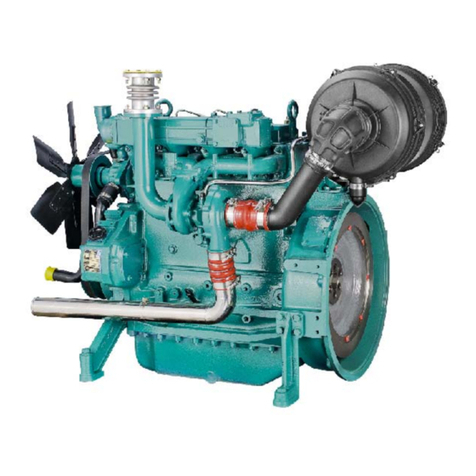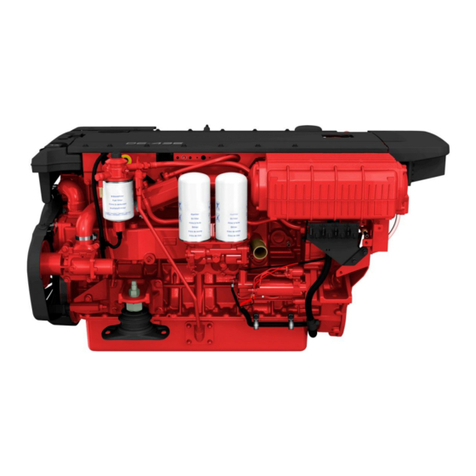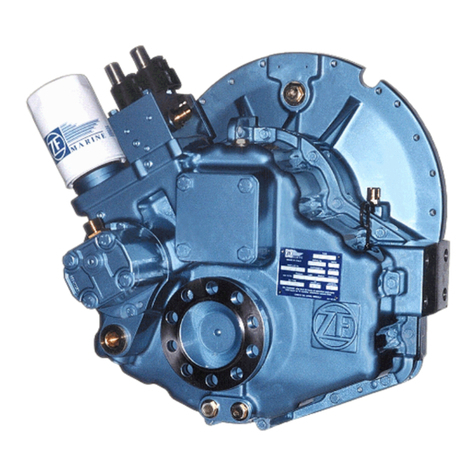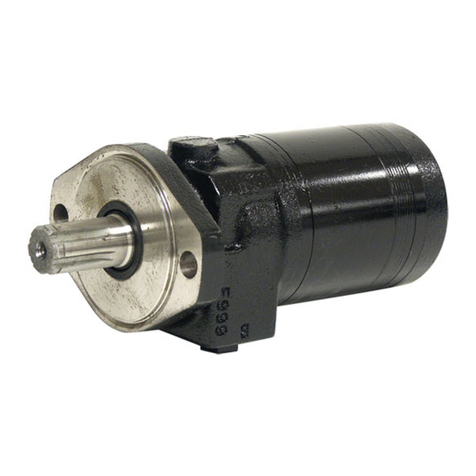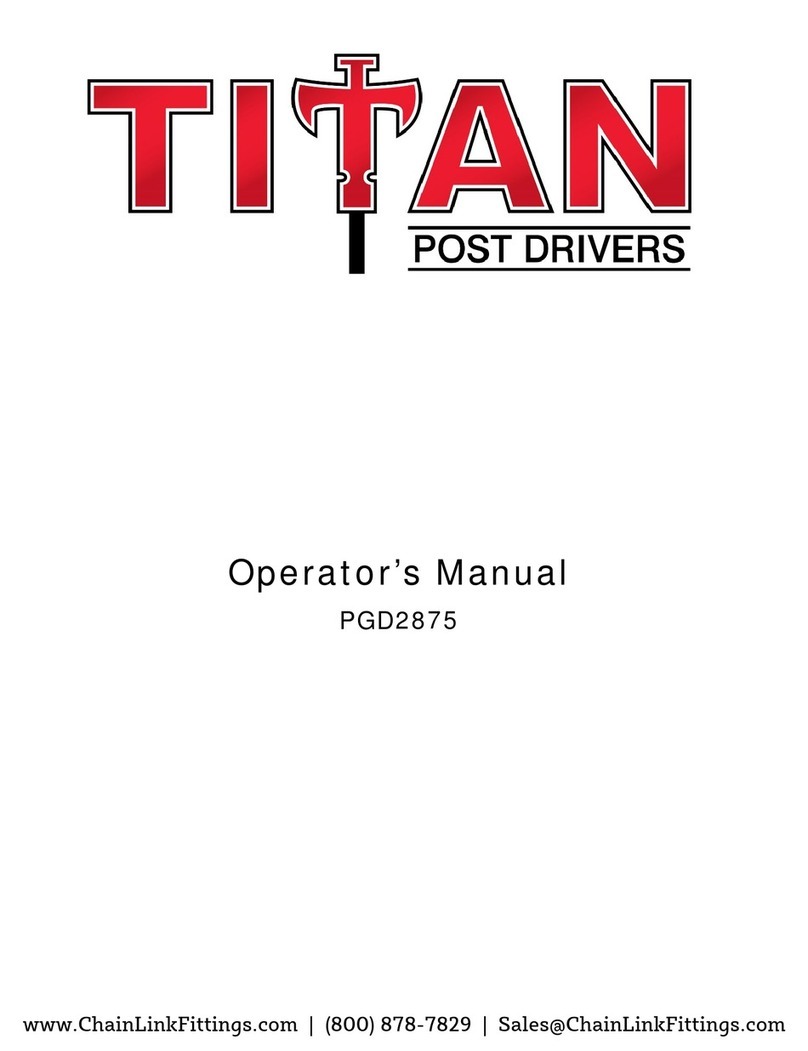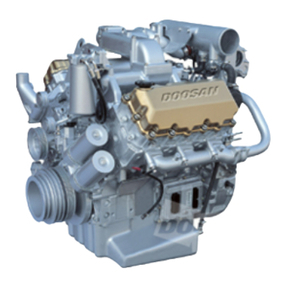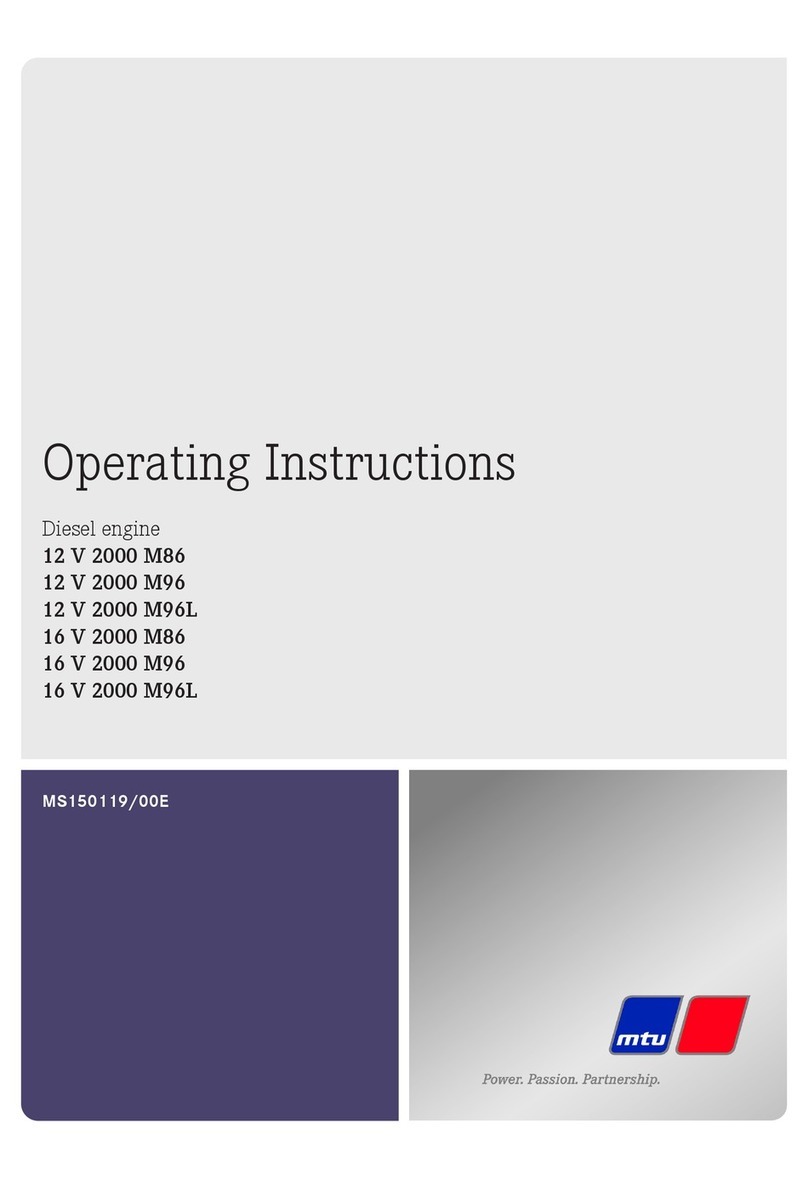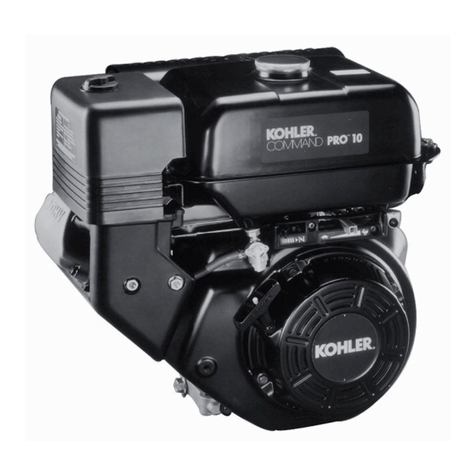Baudoulin 6 M26.2 Operating instructions

www.moteurs-baudouin.com
Société Internationale des Moteurs Baudouin
Technoparc du Brégadan - 13260 Cassis - France
tél. + 33 488 688 500 - fax + 33 488 688 501
Operating and maintenance manual
P/N: 15 18 045 0P
Engine
6 M26.2
Edition: May 2012 - non contractual illustrations
Operating and maintenance manual - Engine 6 M26.2
www.axess-technology.net

00001 - Edition 03 - October 10 Non-contractual illustrations
(*) Société Internationale des Moteurs Baudouin
The information contained in the following pages is correct
at the time of offi cial publication. Given S. I. Moteurs
Baudouin’s continuous improvement and development
policy, information may change at any time, without prior
notice. Before any work, the user should make sure that he
has the most recent published information in his
possession.
Foreword
This Operation and Maintenance Manual must be read
through in its entirety before using the engine. It includes
all the information you will need to enable you to:
- Familiarise yourself with your engine, learn how to use
it and at the same time derive maximum benefit from its
advanced technical features, under the best possible
operating conditions.
- Ensure optimal operational performance simply by strictly
complying with the maintenance recommendations.
- Deal with any minor problems not requiring assistance from
a specialist, without losing too much time.
The inspection and maintenance intervals are given as a
guide, for engines operating under normal conditions. For
severe conditions of engine use, more frequent maintenance
and inspections will be required.
S. I. Moteurs Baudouin* cannot be held liable for any
incidents which may occur due to non-compliance with the
recommendations given in this manual: in particular if the
ingredients used for lubrication and cooling are not of the
required level of performance.
The " DT " technical documents quoted in this Manual
are available from the S. I. Moteurs Baudouin network.
They are regularly up-dated and must be read through in their
entirety.
Spare part references given in this Manual and in the spare
parts catalogue may change; an update is available from
the S. I. Moteurs Baudouin network.
Only use original parts.

- 1/1 -
General summary
00338 - Edition 01 - September 11 Non-contractual illustrations
Warranty Policy
ServiceClassDenition
Safety instructions
Chap A Description
bA100 - Engine description
bA200 - Engine identication
bA300 - Technical data
Chap B Design
bB200 - Cooling system
bB300 - Lubrication system
bB400 - Fuel circuit
bB500 - Air circuit
bB600 - Electrical system
Chap C Engine operation
bC100 - Commissioning
bC200 - Starting the engine
bC300 - Engine operation in use
bC400 - Stopping the engine
Chap D Maintenance
bD100 - Daily servicing operations
bD200 - F1 Servicing operations
bD300 - F2 Servicing operations
bD400 - M1 Maintenance operations
bD500 - M2 Maintenance operations
bD600 - M3 Maintenance operations
bD650 - Annual maintenance operations
bD700 - Overhaul operations
bD800 - Engine wintering
bD900 - Further information
bD1000 - Maintenance table
Chap E Engine follow-up documents
bE100 - Compliance test
bE300 - Sea test sheet


- 1/1 -
Warranty Policy
00433 - Edition 01 - March 12 Non-contractual illustrations
Commissioning documents
Also refer to the Terms and Conditions of Sale of your
engine (see DOC723-05-COM, index B).
Read carefully!
To benet from the terms of our warranty, the engine user
must have commissioning and F1 and F2 technical
inspections described in this document carried out by
personnel from the S. I. Moteurs Baudouin approved
network.
Please refer to chapters D and E for the documents on the
Servicing and Follow-up of your engine.
bOnce commissioning has been effectively carried out, the
personnel of the S. I. Moteurs Baudouin network will send
the following to the head ofce:
vThe installation description sheet (see DT 21.G01-
Commissioning request).
vThe sea test sheet (see sheet E300 - Sea test sheet).
vThe auxiliary generator test sheet (see sheet E300 -
Auxiliary generator test sheet).
vThe generator test sheet (see sheet E301 - Generator
test sheet).
bAfter every F1 or F2 inspection, the Distributor or Agent
from the S. I. Moteurs Baudouin network sends the following
to the head ofce:
vThe F1 sheet relating to the rst inspection (see sheet
D200 - F1 maintenance operations).
vThe F2 sheet relating to the second inspection (see sheet
D300 - F2 maintenance operations).
IMPORTANT
Warranty applications can only be made by the personnel
of the approved network and will only be accepted under
the following conditions:
bReceipt of the commissioning documents at our head
ofce:
vInstallation description sheet.
vSea or generator test sheet.
bThe duly completed online warranty request.
bThe parts used for maintenance, servicing or repairs
must be original S. I. Moteurs Baudouin parts.
bThe approved network representative must ensure that
maintenance operations are carried out in accordance with
the recommendations set out in this manual.
bThe hour meter must be working properly (consult the
commissioning date).
In the event of a dispute concerning maintenance, the
user will provide all invoices for the corresponding
work.
Note: all maintenance supplies will be paid for by the
customer, including costs relating to F1 and F2 inspections.
DT 21.G01


- 1/1 -
Service Class Denition
for Propulsion applications
00004- Edition 03 - October 10 Non-contractual illustrations
Severe continuous application with little or no
engine load/speed variations. Displacement hull.
bEngine average load factor: 80% to 100%
bAnnual duration of use: more than 5,000 hours
bUse under full load: unlimited
Application examples: trawlers, deep-sea vessels, shrimp
boats, high sea or river tug boats, towboats, cargo ships,
dredgers, LCTs, ferries.
Continuous application with frequent variations
in engine speed and load. Displacement or semi-
displacement hull.
bEngine average load factor: 30% to 80%
bAnnual duration of use: 3,000 to 5,000 hours.
bUse under full load: 8 hours in a 12-hour period.
Application examples: passenger vessels, port tugs, self-
propellers, coasters, yachts and cruising sailboats, fast
shing boats such as tuna boats, seiners, pot vessels or
liners, buoying vessels, oceanographic research vessels.
Intermittent application with signicant variations in
engine speed and load. Planing or semi-planing hull.
bEngine average load factor: 50%
bCruising speed y 90% of the engine nominal speed.
bAnnual duration of use: 1,000 to 3,000 hours.
bUse under full load: 2 hours in a 12-hour period.
Application examples: seasonal passenger vessels, shing
launches, pilot boats, commercial pleasure boats, pump
boats, displacement sailboats, trawlers, bow thrusters.
Light application with signicant variations in
engine speed and load. Planing hull.
bEngine average load factor: 30 %
bCruising speed y 80% of the engine nominal speed
bAnnual duration of use: less than 1,000 hours
bUse under full load: 1 hour in a 12-hour period.
Application examples: private pleasure craft, fast vessels
for sea rescue or surveillance, multi-hull pleasure craft.
P1
P2
P3
P4


- 1/12 -
Safety Instructions
00434 - Edition 01 - March 12 Non-contractual illustrations
SAFETY WARNING
Failure to comply with the preventive measures and safety instructions included in this manual
and with warnings indicated on the engine may lead to injury or even death.
This operation and maintenance manual must therefore be kept on board and must be easily
accessible, ready to be consulted at any time.
Furthermore, this manual must stay with the engine if it is sold. The subsequent owner of the
engine will also need the information it contains.
Symbols used in the operation and
maintenance manual
Foreword
As you read this operation and maintenance manual, take
note of the warnings indicating the precautions to be taken to
avoid unsafe practices and conditions.
In this manual, the following symbols are used to highlight
speci c information.
Clearly these safety instructions alone are not suf cient to
avoid danger. The only way to avoid accidents is to strictly
comply with the speci c instructions which apply to each
operation and to use common sense.
Indications of danger
This "Danger" symbol warns against the risk of automatic or
remote start of the installation. The installation must be
isolated prior to any intervention.
This warning sign is recognised across the world. In this
guide, it is used to highlight the importance of the information
that follows. Make sure that you understand the
consequences of a dangerous situation and the ways in which
to avoid danger. Failure to comply with warnings can result in
material damage, injury or even death.
We often see an indication of danger as a general warning. In
this Manual, there are different types of warning depending on
the possible consequences of the danger (minor injury,
serious injury, death).
This type of warning indicates a potentially dangerous
situation which, if not avoided, MAY result in serious
injury or even death, or considerable material damage.
This type of warning indicates a potentially dangerous
situation which, if not avoided, may result in minor
injury or material damage. It can also warn against
dangerous practices.
WARNING
AUTOMATIC OR
REMOTE START

- 2/12 -
00434 - Edition 01 - March 12
Safety Instructions
Non-contractual illustrations
This kind of note provides information on how to proceed
correctly with the operation and maintenance of the
S. I.
Moteurs Baudouin
product.
While simply reading this
document cannot eliminate all risks, proper understanding of
the information it contains will facilitate correct use.
Note
The warnings in this guide cannot cover every situation
imaginable. Use common sense! If you decide to use a
procedure, method, tool or part not speci cally
recommended, make sure that this does not pose any danger
to yourself and others or the equipment.
Key to symbols
Safety symbols
Symbol De nition
Wear hand protection
Wear ear protection
Wear eye protection
Wear head protection
Wear foot protection
Wear a protective mask
Wear overalls
Avoid naked ames
Do not smoke
.
Do not use a mobile phone
Danger: battery acid
Danger: live cables, electrical risk
Highly ammable product
Keep away from hanging loads
Keep an extinguisher close by

- 3/12 -
Safety Instructions
00434 - Edition 01 - March 12 Non-contractual illustrations
Key to tools used
Symbol Denition
2.5mm hexagonal wrench
5mm hexagonal wrench
88mm socket
Flat screwdriver
S
Special tool
10 10mm at hexagonal wrench
Many potential risks can arise during the use of the engine
without warning. It is therefore impossible for this manual to
give a warning for every potential risk. If you use a procedure
which is not specically recommended, make sure that it is
safe and will not cause material damage.
Anyone using a method or tool not recommended by
S. I. Moteurs Baudouin must make sure that they are not
endangering their life or that of others and that the usage,
maintenance or repair method is not likely to cause damage
or compromise safety.

- 4/12 -
00434 - Edition 01 - March 12
Safety Instructions
Non-contractual illustrations
Health Protection Precautions
The list of “Health Protection Precautions” below is designed
to reduce the risk of contamination.
1Avoid prolonged and repeated contact with used engine oil.
2 Wear protective clothing, including waterproof gloves, if
applicable.
3 Do not put oil-soaked cloths in pockets.
4 Avoid contaminating clothing with oil, in particular underwear.
5 Wash overalls regularly. Throw away unwashable clothing and
shoes impregnated with oil.
6 Emergency treatment must be immediately sought in the event of
cuts and injuries.
7 Always apply protective cream before working; this will make it
easier to remove mineral oil from the skin.
8 Wash with soap and hot water or, alternatively, use hand
detergent and a nailbrush to make sure that all oil is removed.
Products containing lanolin can help replace the skin's natural oils
which may have been removed.
9 DO NOT use petrol, kerosene, fuel, thinners or solvents to clean
the skin.
10 If skin problems occur, immediately consult a doctor.
11 If possible, degrease components before handling them.
12 When there are risks for the eyes, use safety glasses or a face
shield. An eye-rinsing solution must be kept close at hand.
13 Do not spill oil or other uids on the ground when repairing the
engine. In the event of an accidental spillage of hydrocarbon or
other uid, take all the necessary measures to section off the
area, clean up and protect people and the environment.
14 The handling, storage and recycling of hydrocarbons, ethylene,
glycol and oil must comply with the safety and environmental
standards applicable in the country where these operations take
place.
Environmental precaution
Asbestos
The products and spare parts supplied by S. I.
Moteurs Baudouin do not contain asbestos.
There are laws regarding environmental protection and the
disposal of waste and hydrocarbons. To ensure compliance
with environmental protection laws, consult your local
authorities who will advise you.

- 5/12 -
Safety Instructions
00434 - Edition 01 - March 12 Non-contractual illustrations
General precautions for operation
Foreword
Most accidents associated with the use, maintenance and
repair of the engine are due to failure to comply with safety
rules and basic precautions. They could therefore be avoided
by acknowledging the risks you face and taking the
corresponding preventive measures.
To operate, maintain and repair this engine, you must have the
required training, skills and tools.
Failure to comply with the instructions set out in this manual
may result in serious or fatal accidents.
S. I. Moteurs Baudouin cannot foresee every possible risk.
Consequently, the safety rules and instructions set out in this
manual are not exhaustive.
Before any operation involving an engine, a
reduction gear/reversing assembly, a line shaft,
a generator or more generally any S. I. Moteurs
Baudouin product:
bBefore any maintenance or repair operation, place a “Do
not use” or similar sign on the starter switches.
bActuate the starter battery isolation switch.
bLower the circuit breaker located on the engine connection
box if there is one.
bMove the machine cabinet starter switch to "OFF" (optional
feature).
bFor engines tted with a pneumatic starter system, isolate
the tanks and drain the pipe linking the tanks to the starter.
bFor engines tted with an automatic starter control system,
lock the starting order on the control cabinet.
bRemove and isolate the bridge panel key.
bBefore using the barring rod, take the necessary
precautions for its use.
bAccess to near the equipment is only authorised for
qualied personnel.
bMake sure that the repair premises and surrounding area
are suitable for safe working.
bMake sure that the repair workshop or the area around the
engine is clean and tidy.
bRemove any rings, chains and watches before starting
work. Wear suitable and close-tting work clothes.

- 6/12 -
00434 - Edition 01 - March 12
Safety Instructions
Non-contractual illustrations
bVerify the expiry date of appropriate protective equipment
(goggles, gloves, shoes, masks, overalls, helmet etc.) before
beginning work.
bDo not use faulty or unsuitable tools.
bStop the engine during maintenance or repair work.
Lifting device
bUse lifting devices to lift and move heavy parts
(over 20kg).
Check the condition of lifting hooks and chains.
The resistance of a lifting ring is
reduced as the angle between the
slings or chains and the engine hoist
points falls below 90°.
Use a lifting device with crossbars as
illustrated opposite. Avoid any contact
between the slings and the engine
parts. Use fastening links and
properly calibrated slings or chains.
Lifting the engine with a reduction gear
Lifting the engine

- 7/12 -
Safety Instructions
00434 - Edition 01 - March 12 Non-contractual illustrations
bBefore using the handling equipment, make sure that it has
been checked and certied as compliant by a certication
body. The engine lifting rings must not touch the side parts of
the engine during lifting.
bNever work under an engine or reduction gear or load that
has been left hanging in a lifting device or hoist.
bUse suitable, resistant supports, in proper working order to
handle an engine, reduction gear or generator.
Lifting the engine with a reduction gear (cont'd)
Lifting the generator

- 8/12 -
00434 - Edition 01 - March 12
Safety Instructions
Non-contractual illustrations
Start-up
bNever use any product to facilitate start-up (risk of
explosion).
bNever start an engine, engage a gear reducer or touch a
propeller pitch control without checking that this operation can
be carried out without danger to people or equipment.
bWhen starting the engine, use ear protection to prevent
hearing loss.
bOnly start or stop the engine using the switches designed
for this purpose in the machine room cabinets, bridge panel,
control cabinets etc.
Seals
bWhen the temperature exceeds 300°C, the seals made of
VITON produce corrosive hydrouoric acid. Always use
protective gear when touching seals subject to high
temperatures.
bUse thick rubber gloves and safety goggles during
decontamination operations.
bClean the seals and contaminated surfaces using a 10%
calcium hydroxide solution or another cleaning product.
bKeep all parts which have been removed in sealed plastic
bags and store them in areas dedicated to this purpose.
Starter battery
bDisconnect the batteries before any operation involving the
electrical circuit.
bAs battery gas is explosive, keep it away from naked
ames and any source of sparks.
bDo not smoke near the fuel circuit and batteries.
bNever check battery charge by short-circuiting it.
bDo not charge a frozen battery; heat it up to 16°C
beforehand.
bSulphuric acid contained in batteries is toxic and corrosive;
it can burn clothes and skin or even cause blindness in case
of contact with the eyes.
bTo avoid accidents:
vFill the batteries in well ventilated premises
vWear suitable gloves and goggles
vDo not inhale the fumes
bIn the event of contact with part of the body:
vRinse the affected part with plenty of water.
vApply bicarbonate of soda or lime to neutralise the acid.
vRinse the eyes for 10 to 15 minutes.
vSee a doctor as soon as possible.

- 9/12 -
Safety Instructions
00434 - Edition 01 - March 12 Non-contractual illustrations
bIn the event of ingestion:
vSee a doctor as soon as possible.
bDo not smoke in areas where batteries are charged.
bThe batteries release ammable fumes which can explode.
bIf the batteries are in a closed area, make sure there is
sufcient ventilation.
bMake sure the batteries are clean and tted with covers.
bThe battery cables must be tted with a circuit breaker to
isolate the circuit if there is a problem. Electric wiring must be
kept in good condition, properly positioned and soundly
attached.
Injection pump
Recommendations for engines equipped with a
high-pressure common rail (HPCR) or traditional
injection engines.
bHigh pressure fuel spray can cause irreversible body
damage. Wear required protection when conducting
operations on the entire circuit.
bMake sure that the lines are depressurised before any
dismantling operations.
bRelease the high pressure before handling the feed and
injection circuit of a HPCR engine.
bWhen checking the injectors, make sure that the high
pressure jet does not touch the skin.
bAll investigations of leaking fuel, oil or other high pressure
liquids must be conducted using a screen and never with
bare hands.
bUse a spray fumes extracting device.
bIf fuel comes into contact with the skin, it can cause injury.
Consult a doctor immediately.
bFuel, oil and coolant contain harmful chemicals.
Avoid any contact with skin and hands; do not ingest. The
use of gloves and safety goggles is highly recommended.
Cleaning the engine or other products
bComply with the safety instructions indicated for the
washing machine used.
bProtect all orices. Do not wash an engine in operation or
which has just stopped.
bUse the safety equipment required by such machines.
bMake sure high-pressure water cannot damage the
equipment being washed.

- 10/12 -
00434 - Edition 01 - March 12
Safety Instructions
Non-contractual illustrations
Servicing
Certain service operations can only be performed with special
tools, therefore it is strongly advised for mechanics not
equipped for major repairs to consult their S. I. Moteurs
Baudouin dealer.
Welding
bComply with all legal provisions in force before conducting
welding work.
bDo not use open res.
bFor all electrical or autogenous welding, use a welding
permit to secure the area.
bMake sure that the work will not affect the on-board
electrical and electronic equipment.
bMake sure that the automatic re suppression system is
deactivated before any welding or grinding work.
bMake sure that there is suf cient ventilation in the premises
where welding is to be carried out.
bDo not weld and do not use a torch on pipes or hoses
containing ammable liquids.
Preventing fi res and burns
Preventing fi res and explosions
bDo not remove inspection doors from the engine block or
reduction gear after an emergency stop. Wait at least
15 minutes to avoid any risk of explosion.
bOil or fuel projections or leaks onto hot surfaces can cause
re.
bMake sure that the pipes and hoses are not worn or
damaged.
bPipes must be positioned, supported and rmly fastened.
bTighten all connections to the recommended torque.
bRegularly clean the engine surface to remove any greasy
deposits which may be ammable.
bDo not smoke while lling the fuel tank or while in the lling
area.
bMobile phones (in particular their batteries) may give off
sparks which could cause an explosion in certain high-risk
areas. Switch off all mobile phones when lling the fuel tank or
while in the lling area.
bStore all fuels and lubricants in closed, clearly labelled
containers in a safe place.
Take necessary precautions when using a high-
pressure cleaner. Do not get electrical equipment,
seals etc. wet so as not to damage them.
.

- 11/12 -
Safety Instructions
00434 - Edition 01 - March 12 Non-contractual illustrations
bSoiled cloths and other ammable materials must not be
stored in the machine room.
bDo not smoke in areas where batteries are charged.
bThe batteries release ammable fumes which can explode.
bIf the batteries are in a closed area, make sure there is
suf cient ventilation.
bMake sure the batteries are clean and tted with covers.
bThe battery cables must be tted with a circuit breaker to
isolate the circuit if there is a problem. Electric wiring must be
kept in good condition, properly positioned and soundly
attached.
bAll wires should be of the recommended size.
bWires and cables must be protected by a fuse or calibrated
circuit breaker.
bDo not short-circuit fuses and/or circuit breakers.
bDo not weld and do not use a torch on pipes or hoses
containing ammable liquids.
bBefore welding or ame cutting, carefully clean the inside
and outside of hoses or pipes using a non- ammable solvent.
bDo not expose the engine to ames.
bMake sure adequate, non-expired extinguishers are
available and know how to use them.
Preventing burns:
bDo not touch the hot parts of an engine in operation or
which has just stopped.
bDo not touch an engine in operation.
bLet the engine cool down before carrying out any
maintenance operation.
bRelease the pressure on the greasing, fuel and cooling
circuits before disconnecting or removing hoses or associated
parts.
bAt operating temperature, the coolant is hot and
pressurised. When pressure is released sharply, this burning-
hot liquid may be transformed into fumes.
bAny contact with this burning-hot liquid or these fumes may
cause serious burns.
bLet the components of the coolant circuit cool down before
draining the circuit.
bOnly check the coolant level when the engine has stopped.
bSlowly unscrew the ller plug to release pressure.
bHot oil can cause injury. Avoid contact with the skin.
bSulphuric acid contained in batteries is toxic and corrosive;
it can burn clothes and skin or even cause blindness in case
of contact with the eyes.

- 12/12 -
00434 - Edition 01 - March 12
Safety Instructions
Non-contractual illustrations
DT 21.GO3
Risks associated with the power generator
It is strictly prohibited to commission an alternator, new or
otherwise, if the isolation is less than 1 Mohm for the stator
and 100,000 ohms for the other windings.
Maintenance and repair operations must be complied with to
avoid any risk of accident and keep the alternator in its
original condition.
All operations (connections or verications) on the alternator
terminals must be carried out while the alternator is switched
off.
It is possible to start and operate the alternator if the
installation complies with the rules and instructions dened in
the manufacturer's manual (see installation and maintenance
manual provided with the alternator).
At this point, we strongly advise you to take the
time to read the safety instructions described in the
previous pages.
Consult Technical Documentation DT 21.GO3 -
Cathodic Protection
Electrical risks
Isolation checks must be carried out regularly.
The electrical circuit of the engine must be isolated from the
engine and boat earth.
Isolation problems can cause short-circuits or stray current.
Stray current can damage bushing or crankshaft seating and
may also cause radio-frequency disturbance.
The engine earth must be properly connected to the boat
earth as well as all the exible hoses in the coolant and fuel
circuits.
Earth faults can cause corrosion in the pipes and engine or
propulsion unit components.
Table of contents
Other Baudoulin Engine manuals
Popular Engine manuals by other brands

Westerbeke
Westerbeke L-25 Operator's manual
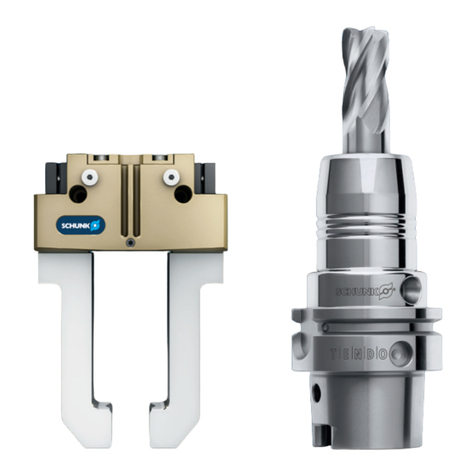
SCHUNK
SCHUNK LDM Series Assembly and operating manual
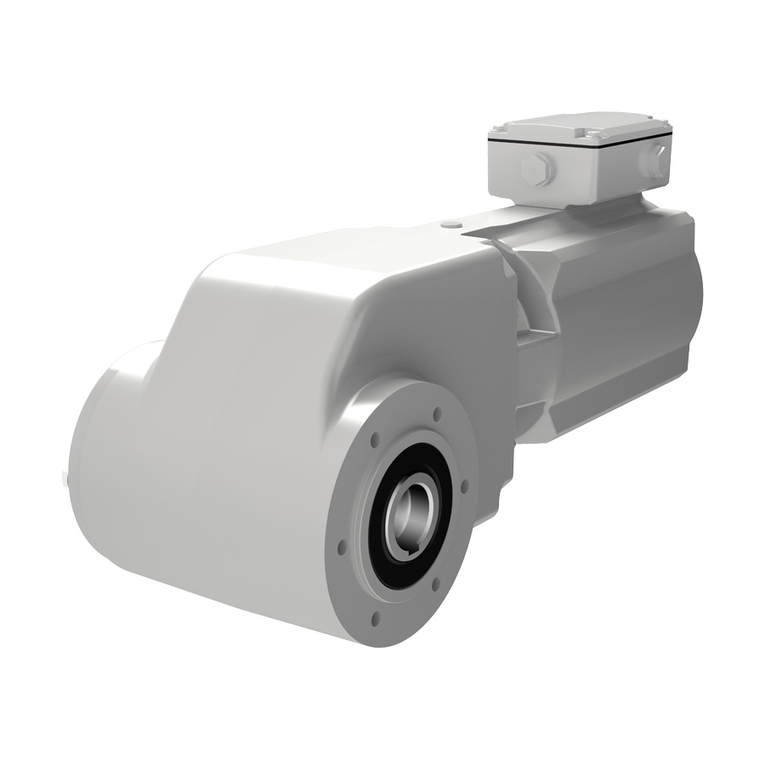
Danfoss
Danfoss VLT OneGearDrive operating guide

Lombardini
Lombardini LDW 502 M Use and maintenance
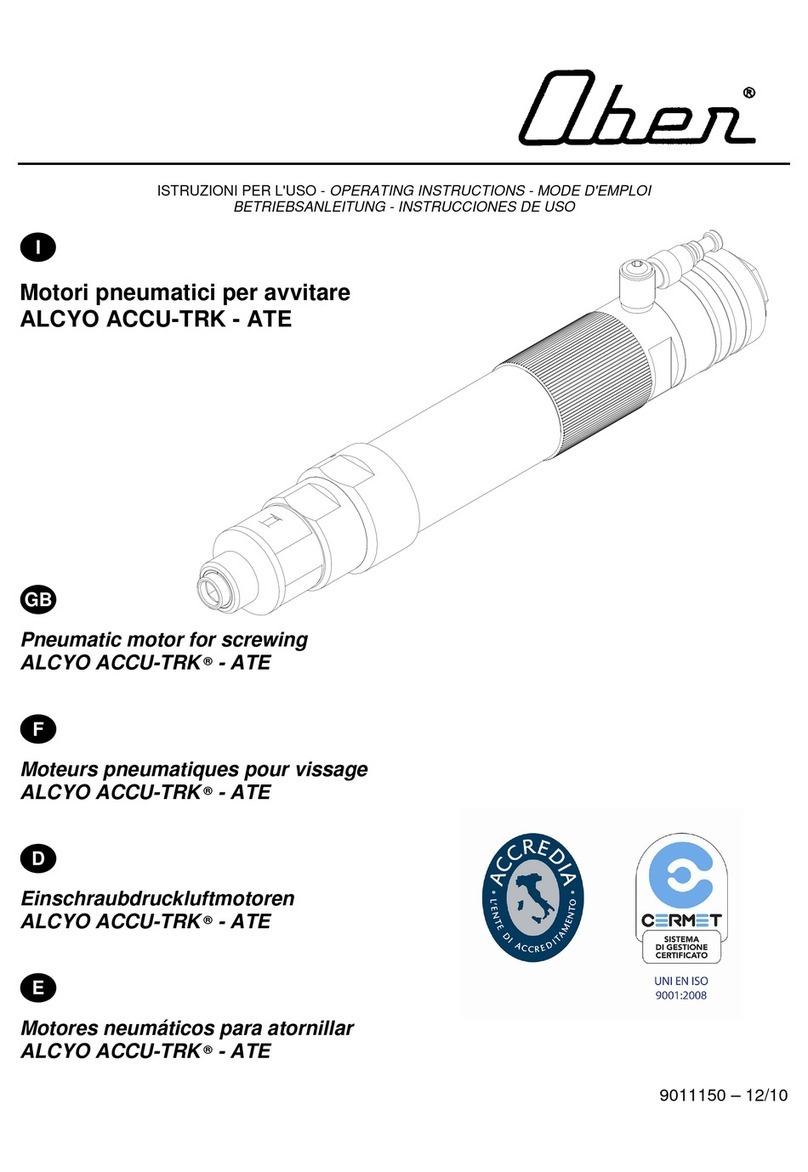
Oben
Oben ALCYO ACCU-TRK-AT operating instructions
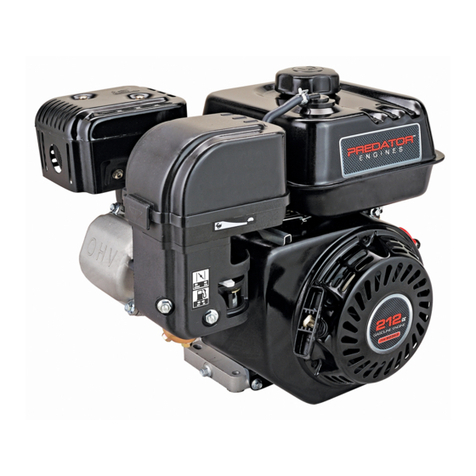
Predator Engines
Predator Engines 69727 Owner's manual & safety instructions
